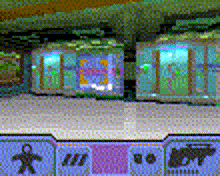| media | ||
| programs | ||
| LICENSE | ||
| raycastlib.h | ||
| README.md | ||
raycastlib
Ray casting library for (not only) limited-resource computers.
If you like this, you may also like my similar project: small3dlib.
eye-candy previews
Pokitto:
SDL:
Arduboy:
terminal:
Gamebuino META:
features
- Very fast, small and efficient.
- Uses only integer math (32bit).
- No dependencies (uses only stdint standard library), extremely portable.
- Single header, KISS.
- Advanced rendering of variable height floor and ceiling.
- Textured walls and floor.
- Depth information (e.g. for fog or z-buffer rendering).
- Camera shearing (looking up/down).
- Camera movement with collisions.
- Partial support for opening door.
- Pure C99, tested to run as C++ as well.
- Optional framework functions that handle the whole rendering.
- Still flexible -- pixels are left for you to draw in any way you want.
- Tested on multiple platforms (PC, Arduboy, Pokitto, Gamebuino META).
- Many compile-time options to tune the performance vs quality.
- Well commented and formatted code.
NOTE: Backwards compatibility isn't a goal of this libraray. It is meant to be an as-is set of tools that the users is welcome to adjust for their specific project. So new features will be preferred to keeping the same interface.
how to use
For start take a look at the testTerminal.c program. It is only a little bit more complex than a simple hello world.
For more examples see the other files, plus my Pokitto demos repository, which contains some better documented example code, including a very simple hello world.
The basic philosophy is:
- The library implements only a rendering back-end, it doesn't permorm any drawing to the actual screen, hence there is no dependency on any library such as OpenGL or SDL. It just calls your front-end function and tells you which pixels you should write. How you do it is up to you.
- Before including the header, define
RCL_PIXEL_FUNCTIONto the name of a function you will use to draw pixels. It is basically a fragment/pixel shader function that the library will call. You will be passed info about the pixel and can decide what to do with it, so you can process it, discard it, or simply write it to the screen. - Call
RCL_renderSimpleorRCL_renderComplexto perform the frame rendering. This will cause the library to start calling theRCL_PIXEL_FUNCTIONin order to draw the frame. You can optionally write a similar function of your own using the more low-level functions which are also provided. - The library gets info about the world (such as floor or ceiling height) via array functions
(
RCL_ArrayFunctiontype) -- functions that take x and y coordinates of a square and return given information. This way you are free to not only fetch the map data from an array, but also generate the world procedurally if that is what you want. - Fixed point arithmetics is used as a principle, but there is no abstraction above it, everything is simply
an integer (
RCL_Unittype). The space is considered to be a dense grid, where each world square has a side length ofRCL_UNITS_PER_SQUAREunits. Numbers are normalized by this constant, so e.g. the sin function returns a value from-RCL_UNITS_PER_SQUAREtoRCL_UNITS_PER_SQUARE.
TODO
- Transparency (conditional ray passing through).
- Doors in the middle of squares.
- Rolling doors for
RCL_renderComplex. - Possibly merge all rendering functions into one.
license
Everything is CC0 1.0 + a waiver of all other IP rights (including patents). Please share your own software as free and open-source.







